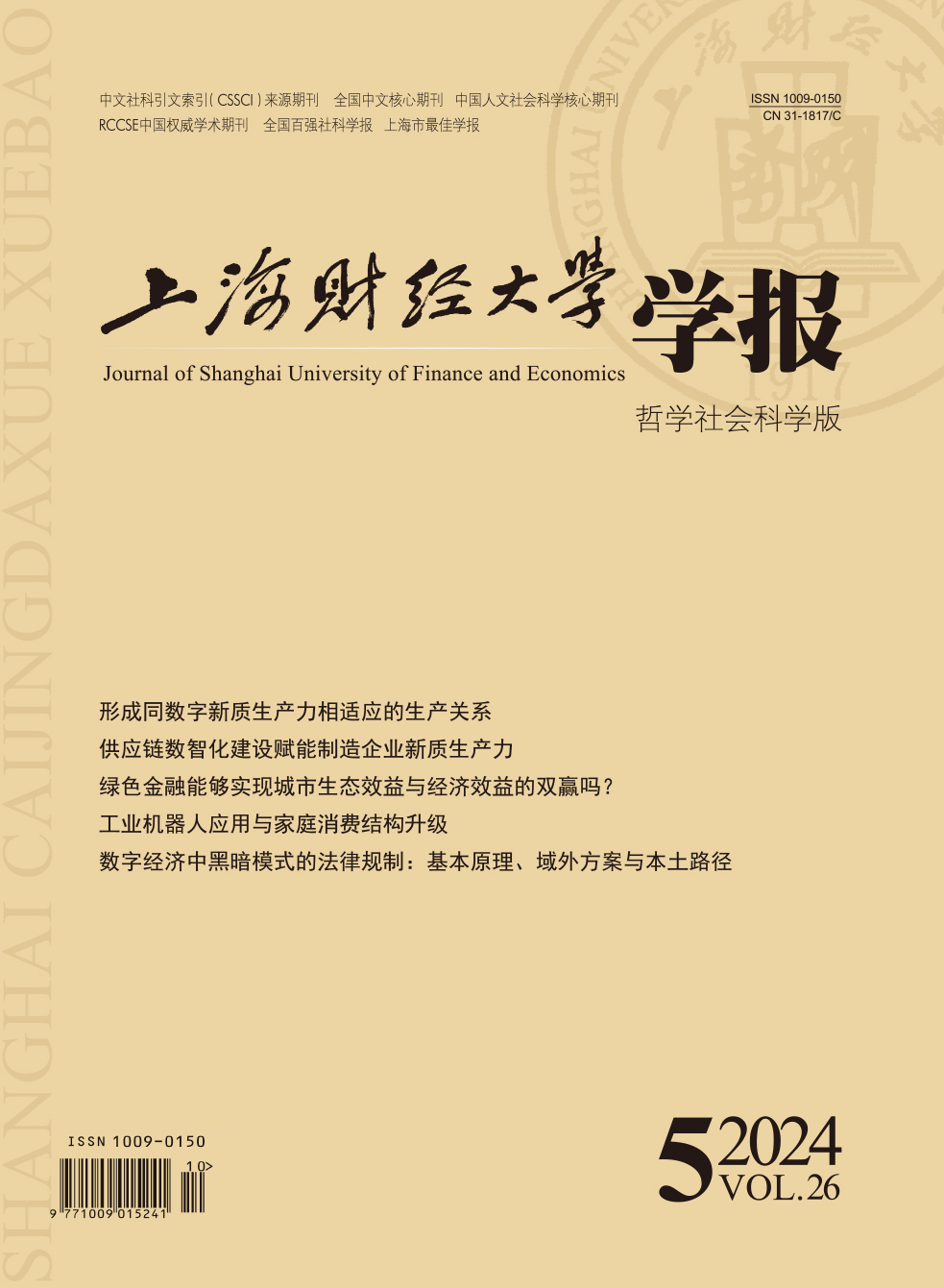随着工业机器人技术的快速发展和广泛应用,家庭消费决策变动背后的技术性因素日益引发关注。文章基于2010—2020年中国家庭追踪调查(CFPS)数据,以家庭消费结构变动为切入点,探究了工业机器人应用对中国家庭消费的深远影响。研究发现,工业机器人应用抑制了家庭消费结构升级,尤其减少了发展型和享受型消费,影响机制包括家庭创收水平下降和社会网络双重收缩。细分消费支出类型结果发现,家长在内部教育资源配置中倾向于削减自身的人力资本投资以增加子女教育投入,期望子女能更好地应对未来的技术冲击。异质性检验结果显示,工业机器人应用在不同的家庭背景、劳动市场条件和区域会因技术进步偏向呈现出显著差异。进一步分析发现,电子商务进农村综合示范政策缓解了机器人应用导致的就业问题,通过支持返乡创业和就近就业,改善了家庭消费结构。研究结论深化了对工业机器人应用经济后果的认识,并为消费结构优化提供了新视角与实践指导。
工业机器人应用与家庭消费结构升级——基于创收水平与社会网络冲击视角的分析
摘要
参考文献
2 陈媛媛,张竞,周亚虹. 工业机器人与劳动力的空间配置[J]. 经济研究,2022,(1).
3 樊纲,王小鲁,马光荣. 中国市场化进程对经济增长的贡献[J]. 经济研究,2011,(9).
5 杭斌. 人情支出与城镇居民家庭消费——基于地位寻求的实证分析[J]. 统计研究,2015,(4). DOI:10.3969/j.issn.1002-4565.2015.04.015
7 孔高文,刘莎莎,孔东民. 机器人与就业——基于行业与地区异质性的探索性分析[J]. 中国工业经济,2020,(8). DOI:10.3969/j.issn.1006-480X.2020.08.009
8 刘铠豪,臧旭恒,王雪芳. 贸易自由化与家庭消费——来自中国城镇住户调查的微观证据[J]. 中国工业经济,2022,(3). DOI:10.3969/j.issn.1006-480X.2022.03.003
10 刘洋,韩永辉,王贤彬. 工业智能化能兼顾促增长和保民生吗?[J]. 数量经济技术经济研究,2023,(6).
11 秦海林,高軼玮. 社会资本、消费行为选择与消费升级——基于CFPS(2016)的实证检验[J]. 消费经济,2019,(6).
16 田鸽,张勋. 数字经济、非农就业与社会分工[J]. 管理世界,2022,(5).
17 王林辉,胡晟明,董直庆. 人工智能技术、任务属性与职业可替代风险:来自微观层面的经验证据[J]. 管理世界,2022,(7).
18 王林辉,钱圆圆,宋冬林,等. 机器人应用的岗位转换效应及就业敏感性群体特征——来自微观个体层面的经验证据[J]. 经济研究,2023,(7).
19 王永钦,董雯. 机器人的兴起如何影响中国劳动力市场?——来自制造业上市公司的证据[J]. 经济研究,2020,(10).
20 魏勇. 社会保障、收入门槛与城镇居民消费升级[J]. 社会保障评论,2017,(4).
21 吴汉东. 人工智能时代的制度安排与法律规制[J]. 法律科学(西北政法大学学报),2017,(5).
24 余向华,陈雪娟. 中国劳动力市场的户籍分割效应及其变迁——工资差异与机会差异双重视角下的实证研究[J]. 经济研究,2012,(12).
25 张琛,马彪,彭超. 农村电子商务发展会促进农村劳动力本地就业吗[J]. 中国农村经济,2023,(4).
26 张军,闫雪凌,余沭乐,等. 工业机器人应用与劳动关系:基于司法诉讼的实证研究[J]. 管理世界,2023,(12).
27 赵涛,张智,梁上坤. 数字经济、创业活跃度与高质量发展——来自中国城市的经验证据[J]. 管理世界,2020,(10).
28 甄浩,贾男. 机器人使用加剧了农村劳动力回流吗[J]. 当代财经,2022,(12).
29 Acemoglu D, Restrepo P. Robots and jobs: Evidence from US labor markets [J]. Journal of Political Economy, 2020, 128(6): 2188–2244.
30 Aghion P, Antonin C, Bunel S. The power of creative destruction: Economic upheaval and the wealth of nations[M]. Cambridge, MA: Harvard University Press, 2021.
31 Autor D H, Dorn D, Hanson G H. Untangling trade and technology: Evidence from local labour markets [J]. The Economic Journal, 2015, 125(584): 621–646.
32 Autor D H, Levy F, Murnane R J. The skill content of recent technological change: An empirical exploration [J]. The Quarterly Journal of Economics, 2003, 118(4): 1279–1333.
33 Chen Y Y, Huang Y N, Wang H. How do households respond to income shocks: Evidence from urban China from 1992 to 2003[EB/OL]. http://dx. doi.org/10.2139/ssrn.2277691, 2013-06-11.
34 Danzer A M, Dietz B, Gatskova K, et al. Showing off to the new neighbors? Income, socioeconomic status and consumption patterns of internal migrants [J]. Journal of Comparative Economics, 2014, 42(1): 230–245.
35 Dauth W, Findeisen S, Suedekum J, et al. The adjustment of labor markets to robots [J]. Journal of the European Economic Association, 2021, 19(6): 3104–3153.
36 Duesenberry J S. Income, saving, and the theory of consumer behavior[M]. Cambridge: Harvard University Press, 1949.
37 Gasteiger E, Prettner K. Automation, stagnation, and the implications of a robot tax [J]. Macroeconomic Dynamics, 2022, 26(1): 218–249.
38 Giuntella O, Lu Y, Wang T Y. How do workers and households adjust to robots? Evidence from China[R]. National Bureau of Economic Research Working Papers 30707, 2022.
39 Goldfarb A, Tucker C. Digital economics [J]. Journal of Economic Literature, 2019, 57(1): 3–43.
40 Karabarbounis L, Neiman B. The global decline of the labor share [J]. The Quarterly Journal of Economics, 2014, 129(1): 61–103.
41 Keynes J M. The general theory of employment, interest and money[M]. New York: Harcourt, Brace, 1936.
42 Maslow A H. A theory of human motivation [J]. Psychological Review, 1943, 50(4): 370–396.
43 Modigliani F, Brumberg R. Utility analysis and the consumption function: An interpretation of cross-section data[A]. Kurihara K. Post Keynesian economics[M]. New Brunswick: Rutgers University Press, 1954.
44 Schlogl L, Sumner A. Disrupted development and the future of inequality in the age of automation[M]. Cham, Switzerland: Palgrave Pivot, 2020.
引用本文
叶劲松, 方嘉彬, 黄远浙, 等. 工业机器人应用与家庭消费结构升级——基于创收水平与社会网络冲击视角的分析[J]. 上海财经大学学报, 2024, 26(5): 75-91.
导出参考文献,格式为:





 4007
4007  6477
6477

